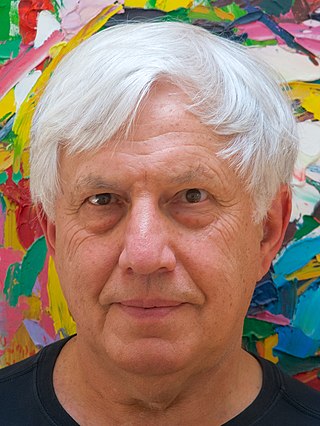The anthropic principle, also known as the "observation selection effect", is the hypothesis, first proposed in 1957 by Robert Dicke, that the range of possible observations that we could make about the universe is limited by the fact that observations could only happen in a universe capable of developing intelligent life in the first place. Proponents of the anthropic principle argue that it explains why this universe has the age and the fundamental physical constants necessary to accommodate conscious life, since if either had been different, we would not have been around to make observations. Anthropic reasoning is often used to deal with the notion that the universe seems to be finely tuned for the existence of life.
In physical cosmology, cosmic inflation, cosmological inflation, or just inflation, is a theory of exponential expansion of space in the early universe. The inflationary epoch is believed to have lasted from 10−36 seconds to between 10−33 and 10−32 seconds after the Big Bang. Following the inflationary period, the universe continued to expand, but at a slower rate. The acceleration of this expansion due to dark energy began after the universe was already over 7.7 billion years old.
The multiverse is a hypothetical group of multiple universes. Together, these universes are presumed to comprise everything that exists: the entirety of space, time, matter, energy, information, and the physical laws and constants that describe them. The different universes within the multiverse are called "parallel universes", "other universes", "alternate universes", or "many worlds". One common assumption is that the multiverse is a "patchwork quilt of separate universes all bound by the same laws of physics."
In physics, string theory is a theoretical framework in which the point-like particles of particle physics are replaced by one-dimensional objects called strings. String theory describes how these strings propagate through space and interact with each other. On distance scales larger than the string scale, a string looks just like an ordinary particle, with its mass, charge, and other properties determined by the vibrational state of the string. In string theory, one of the many vibrational states of the string corresponds to the graviton, a quantum mechanical particle that carries the gravitational force. Thus, string theory is a theory of quantum gravity.

In cosmology, the cosmological constant, alternatively called Einstein's cosmological constant, is the constant coefficient of a term that Albert Einstein temporarily added to his field equations of general relativity. He later removed it. Much later it was revived and reinterpreted as the energy density of space, or vacuum energy, that arises in quantum mechanics. It is closely associated with the concept of dark energy.
In physical cosmology, baryogenesis is the physical process that is hypothesized to have taken place during the early universe to produce baryonic asymmetry, i.e. the imbalance of matter (baryons) and antimatter (antibaryons) in the observed universe.
Brane cosmology refers to several theories in particle physics and cosmology related to string theory, superstring theory and M-theory.
In theoretical physics, the anti-de Sitter/conformal field theory correspondence, sometimes called Maldacena duality or gauge/gravity duality, is a conjectured relationship between two kinds of physical theories. On one side are anti-de Sitter spaces (AdS) which are used in theories of quantum gravity, formulated in terms of string theory or M-theory. On the other side of the correspondence are conformal field theories (CFT) which are quantum field theories, including theories similar to the Yang–Mills theories that describe elementary particles.

Leonard Susskind is an American physicist, who is a professor of theoretical physics at Stanford University, and founding director of the Stanford Institute for Theoretical Physics. His research interests include string theory, quantum field theory, quantum statistical mechanics and quantum cosmology. He is a member of the US National Academy of Sciences, and the American Academy of Arts and Sciences, an associate member of the faculty of Canada's Perimeter Institute for Theoretical Physics, and a distinguished professor of the Korea Institute for Advanced Study.
In theoretical physics, F-theory is a branch of string theory developed by Iranian physicist Cumrun Vafa. The new vacua described by F-theory were discovered by Vafa and allowed string theorists to construct new realistic vacua — in the form of F-theory compactified on elliptically fibered Calabi–Yau four-folds. The letter "F" supposedly stands for "Father".

In theoretical physics, the hierarchy problem is the problem concerning the large discrepancy between aspects of the weak force and gravity. There is no scientific consensus on why, for example, the weak force is 1024 times stronger than gravity.

Andrei Dmitriyevich Linde is a Russian-American theoretical physicist and the Harald Trap Friis Professor of Physics at Stanford University.

The black hole information paradox is a puzzle that appears when the predictions of quantum mechanics and general relativity are combined. The theory of general relativity predicts the existence of black holes that are regions of spacetime from which nothing — not even light — can escape. In the 1970s, Stephen Hawking applied the rules of quantum mechanics to such systems and found that an isolated black hole would emit a form of radiation called Hawking radiation. Hawking also argued that the detailed form of the radiation would be independent of the initial state of the black hole and would depend only on its mass, electric charge and angular momentum. The information paradox appears when one considers a process in which a black hole is formed through a physical process and then evaporates away entirely through Hawking radiation. Hawking's calculation suggests that the final state of radiation would retain information only about the total mass, electric charge and angular momentum of the initial state. Since many different states can have the same mass, charge and angular momentum this suggests that many initial physical states could evolve into the same final state. Therefore, information about the details of the initial state would be permanently lost. However, this violates a core precept of both classical and quantum physics—that, in principle, the state of a system at one point in time should determine its value at any other time. Specifically, in quantum mechanics the state of the system is encoded by its wave function. The evolution of the wave function is determined by a unitary operator, and unitarity implies that the wave function at any instant of time can be used to determine the wave function either in the past or the future.

In theoretical physics, compactification means changing a theory with respect to one of its space-time dimensions. Instead of having a theory with this dimension being infinite, one changes the theory so that this dimension has a finite length, and may also be periodic.
Montonen–Olive duality or electric–magnetic duality is the oldest known example of strong–weak duality or S-duality according to current terminology. It generalizes the electro-magnetic symmetry of Maxwell's equations by stating that magnetic monopoles, which are usually viewed as emergent quasiparticles that are "composite", can in fact be viewed as "elementary" quantized particles with electrons playing the reverse role of "composite" topological solitons; the viewpoints are equivalent and the situation dependent on the duality. It was later proven to hold true when dealing with a N = 4 supersymmetric Yang–Mills theory. It is named after Finnish physicist Claus Montonen and British physicist David Olive after they proposed the idea in their academic paper Magnetic monopoles as gauge particles? where they state:
There should be two "dual equivalent" field formulations of the same theory in which electric (Noether) and magnetic (topological) quantum numbers exchange roles.
Cosmological natural selection, also called the fecund universes, is a hypothesis proposed by Lee Smolin intended as a scientific alternative to the anthropic principle. It addresses the problem of complexity in our universe, which is largely unexplained. The hypothesis suggests that a process analogous to biological natural selection applies at the grandest of scales. Smolin published the idea in 1992 and summarized it in a book aimed at a lay audience called The Life of the Cosmos.

The Boltzmann brain thought experiment suggests that it might be more likely for a single brain to spontaneously form in a void rather than for the entire universe to come about in the manner cosmologists think it actually did. Physicists use the Boltzmann brain thought experiment as a reductio ad absurdum argument for evaluating competing scientific theories.

Renata Elizaveta Kallosh is Ukrainian-American a theoretical physicist. She is a Professor of Physics at Stanford University, working there on supergravity, string theory and inflationary cosmology.
A causal patch is a region of spacetime connected within the relativistic framework of causality.
Raphael Bousso is a theoretical physicist and cosmologist. He is a professor at the Berkeley Center for Theoretical Physics in the Department of Physics, UC Berkeley. He is known for the Bousso bound on the information content of the universe. With Joseph Polchinski, Bousso proposed the string theory landscape as a solution to the cosmological constant problem.



















